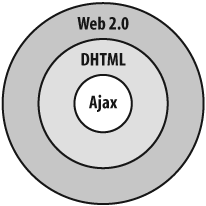Chapter 16. Rule 14: Make Ajax Cacheable
People frequently ask whether the performance rules in this book apply to Web 2.0 applications. They definitely do! The rule discussed in this chapter is, however, the first rule that resulted from working with Web 2.0 applications at Yahoo!. In this chapter, I describe what Web 2.0 means, how Ajax fits into Web 2.0, and an important performance improvement you can make to Ajax.
Web 2.0, DHTML, and Ajax
The relationship between Web 2.0, DHTML, and Ajax is illustrated in Figure 16-1 This figure doesn't show that Ajax is used only in DHTML or that DHTML is used only by Web 2.0 applications, but rather it is meant to show that Web 2.0 includes many concepts, one of which is DHTML, and that Ajax is one of the key technologies in DHTML. A discussion of Web 2.0 and what it includes is a book (or more) by itself, but we do want to have a common understanding of these terms. Below, I give brief definitions with references for more information.

Figure 16-1. Relationship between Web 2.0, DHTML, and Ajax
Web 2.0
O'Reilly Media first used the term "Web 2.0" in 2004, the first year they held the Web 2.0 conference. The term pertains not as much to technology as the social and business aspects of how the next-generation Internet will be used. It alludes to web sites evolving into Internet communities rich in wikis, blogs, and podcasts. Key concepts of Web ...
Get High Performance Web Sites now with the O’Reilly learning platform.
O’Reilly members experience books, live events, courses curated by job role, and more from O’Reilly and nearly 200 top publishers.

